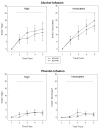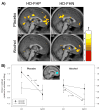Family history of alcoholism mediates the frontal response to alcoholic drink odors and alcohol in at-risk drinkers
- PMID: 20004725
- PMCID: PMC2819594
- DOI: 10.1016/j.neuroimage.2009.11.076
Family history of alcoholism mediates the frontal response to alcoholic drink odors and alcohol in at-risk drinkers
Abstract
Although a family history of alcoholism is the strongest risk factor for developing alcohol dependence, there are few studies of the association between familial alcoholism and the human brain's reward system activity. We used functional magnetic resonance imaging (fMRI) to determine how family history affects the brain's response to subjects' preferred alcoholic drink odors (AO) as compared to appetitive control odors (ApCO). Fourteen non-dependent heavy drinkers (HD) who were family history positive (FHP) participated, as did 12 HD who were family history negative (FHN). Subjects were imaged under both alcohol intoxication and placebo, using intravenous infusion and pharmacokinetic modeling to target a blood alcohol level of 50 mg%. Under placebo, HD-FHP had a larger medial frontal [AO>ApCO] effect than did HD-FHN. Alcohol intoxication dampened this response in the HD-FHP but potentiated it in the HD-FHN. This suggests that a family history of alcoholism and brain exposure to alcohol interact in heavy drinkers to differentially affect how the brain responds to alcohol cues.
Copyright (c) 2009 Elsevier Inc. All rights reserved.
Figures





References
-
- Acheson A, Robinson JL, Glahn DC, Lovallo WR, Fox PT. Differential activation of the anterior cingulate cortex and caudate nucleus during a gambling simulation in persons with a family history of alcoholism: Studies from the Oklahoma Family Health Patterns Project. Drug and Alcohol Dependence. 2009;100:17–23. - PMC - PubMed
-
- Begleiter H, Porjesz B. What is inherited in the predisposition toward alcoholism? A proposed model. Alcoholism: Clinical and Experimental Research. 1999;23:1125–1135. - PubMed
-
- Bjork J, Knutson B, Hommer D. Incentive-elicited striatal activation in adolescent children of alcoholics. Addiction. 2008;103:1308–1319. - PubMed
Publication types
MeSH terms
Substances
Grants and funding
LinkOut - more resources
Full Text Sources
Medical

